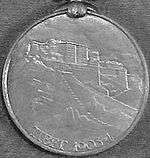Tibet Medal
| Tibet Medal | |
|---|---|
|
Obverse (top left) and reverse (top right) of the medal. Ribbon: red with green edges and white edge stripes | |
| Awarded by United Kingdom of Great Britain and Ireland | |
| Type | Campaign medal |
| Eligibility | British Army. |
| Awarded for | Campaign service. |
| Campaign | Tibet 1903 – 04 |
| Description | Silver or bronze disk 36 mm wide |
| Clasps |
|
| Statistics | |
| Established | 1 February 1905 |
The Tibet Medal was "authorized in February 1905 for for all members of the Tibet Mission and accompanying troops who served at or beyond"[1] Siliguri from 13 December 1903 to 23 September 1904.
The obverse of the medal "carries the bust of Edward VII in Field Marshal's uniform and the legend EDWARDVS VII KAISAR-I-HIND"[2] while the reverse depicts the Potala (winter palace of the Dalai Lamas) in Lhasa on top of the red hill with the words 'TIBET 1903-04' below. The suspender is of the swivelling ornate scroll type.[3]"One bar GYANTSE was given to those who defended, or relieved, that fort"[1]
Most issues of this medal went to Indian troops who along with British personnel were awarded this medal in silver. Camp followers received the medal in bronze.[3]
See also
References
- 1 2 Gould, Robert W. (1982). Campaign Medals of the British Army 1815-1972: An Illustrated Reference Guide for Collectors. Great Britain: Arms and Armour Press. p. 53.
- ↑ Gould, Robert W. (1982). Campaign Medals of the British Army 1815-1972: An Illustrated Reference Guide for Collectors. Great Britain: Arms and Armour Press. p. 53.
- 1 2 Tibet Medal on the British Medals website
External links
- Tibet Medal on the British Medals website
- Tibet Medal 1903-04 on medals.org.uk
- The Tibet Medal on the British Military Medals website
- ↑ Gould, Robert W. (1982). Campaign Medals of the British Army 1815-1972: An Illustrated Reference Guide for Collectors. Great Britain: Arms and Armour Press. p. 53.

